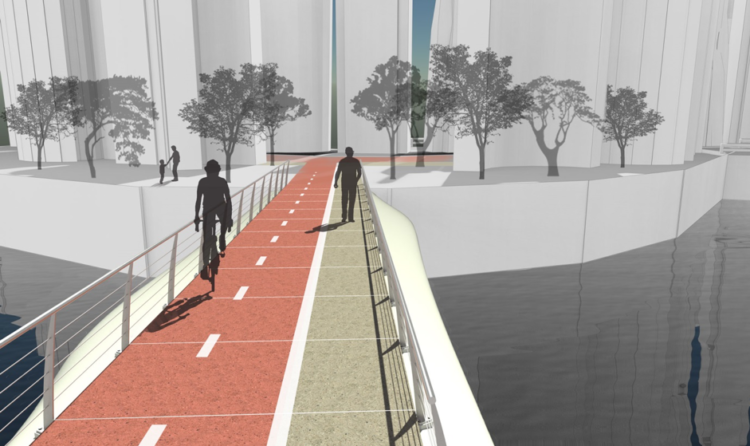Reuse of wind turbine blades in a slow traffic bridge
Sep 2017 - ongoing
The Bridge of Blades shows how decomissioned blades, made of composites, can be re-used in a commercially viable solution.
By Stijn Speksnijder
This master thesis presents a research & design project, aimed at finding a new use for decommissioned wind turbine blades. Wind energy is becoming a major source of renewable energy. As a result, a large stream of wind turbine materials arises. Most of these materials can be recycled very well, but the rotor blades pose a big problem after their lifespan of 20-25 years. These blades consist of complex composite materials that are doomed to end up in landfill or incineration plants, although the high performance material often still possesses excellent mechanical and chemical qualities. This confronts owners and manufacturers of wind turbines with high costs, as they paying ±€100 per tonne of waste to dispose of the blades.
The blade waste problem is steadily growing. By 2050, between 21.4 and 69.4 million tonnes of cumulative wind turbine waste is expected.
On an industrial scale, no proper solutions to the wind turbine blade waste problem have yet been found. Most current solutions involve shredding of the blades, which generally results in loss of material qualities. Some solutions have been found that utilize the structural qualities of the blades. However, these new applications are often ‘occasional solutions’; projects that are interesting but are difficult to upscale in an economically viable way. In order for a new product application to be viable, it is important that the material qualities of the blades are utilized and that the resulting product offers an advantage over its competition.
The solution must be applicable on a worldwide scale to offer a significant reduction of the blade waste problem. To solve this problem, a large amount of ideas was generated during different kinds of creative sessions. Based on the criteria found in the analysis, a slow traffic bridge was chosen as the most promising idea. This bridge was further developed into a concept. The market potential was identified for the ‘Bridge of Blades’, and the product was designed to fit this purpose.


The concept was developed regarding aesthetics, user interaction and structural performance. In the design, the previous life of the bridge is clearly visible. Two rotor blades cross the entire bridge and carry the bridge superstructure. Between the blades, a deck is placed, that provides a comfortable crossing for pedestrians, wheelchairs, bicycles and mopeds. The resulting design is playful, dynamic and tells the story of how high performance materials can be re-used in a commercially viable solution. All components and connections were developed into detail with production and re-use of materials in mind.
At the end of the lifespan of the bridge, all materials can be separated and find a new use in the circular economy. This way, the bridge offers a constructive solution to one problem, prevents new problems and acts as an example to fuel debate regarding material use in the technologies of the future. The concept was evaluated, to predict how it could perform in its context. Approximations of the structural performance and a qualitative analysis of the environmental impact are presented. The thesis is concluded with recommendations for further development and evaluation, that are required to make this concept reality. Finally, recommendations for blade designers are given, to make sure the problems that were faced in this project can be avoided in the future.
To find more about the project you can click here
Supervisory Team
Ruud Balkenende – Chair
Olaf Wit – Mentor
Jelle Joustra – Daily supervisor